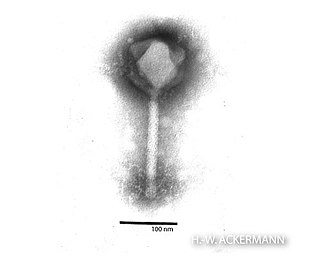Enquatrovirus is a genus of bacteriophages in the order Caudovirales, in the family Podoviridae. Bacteria serve as natural hosts. There is currently only one species in this genus: the type species Escherichia virus N4.
Uetakevirus is a genus of viruses in the order Caudovirales, in the family Podoviridae. Bacteria serve as natural hosts. There are three species in this genus. These phages are temperate and infect Salmonella and Escherichia coli.
Peduovirus is a genus of viruses in the order Caudovirales, in the family Myoviridae, in the subfamily Peduovirinae. Bacteria serve as natural hosts, with transmission achieved through passive diffusion. There are 15 species in this genus.

Schizotequatrovirus is a genus of viruses in the order Caudovirales, in the family Myoviridae, in the subfamily Tevenvirinae. Bacteria serve as natural hosts. There are three species in this genus.
Tequatrovirus is a genus of viruses in the order Caudovirales, in the family Myoviridae, in the subfamily Tevenvirinae. Gram-negative bacteria serve as the natural host, with transmission achieved through passive diffusion. There are 75 species in this genus.
Felixounavirus is a genus of viruses in the order Caudovirales, in the family Myoviridae. Bacteria serve as natural hosts, with transmission achieved through passive diffusion. There are currently 16 species in this genus, including the type species Salmonella virus FelixO1.
Bixzunavirus is a genus of viruses in the order Caudovirales, in the family Myoviridae. Bacteria serve as natural hosts, with transmission achieved through passive diffusion. There are eight species in this genus.
Muvirus is a genus of viruses in the order Caudovirales, in the family Myoviridae. Bacteria serve as natural hosts, with transmission achieved through passive diffusion. There are two species in this genus.

Phikzvirus is a genus of viruses in the order Caudovirales, in the family Myoviridae. Bacteria serve as natural hosts. There are three species in this genus.
Zindervirus is a genus of viruses in the family Autographiviridae, within the subfamily Molineuxvirinae. Bacteria serve as the natural host, with transmission achieved through passive diffusion. There are currently three species in this genus, including the type species Salmonella virus SP6.

Teseptimavirus is a genus of viruses in the order Caudovirales, in the family Autographiviridae, in the subfamily Studiervirinae. Bacteria serve as the natural host, with transmission achieved through passive diffusion. There are currently 17 species in this genus, including the type species Escherichia virus T7.
Salasvirus is a genus of viruses in the order Caudovirales, in the family Salasmaviridae, in the subfamily Picovirinae. Bacteria serve as natural hosts. There are four species in this genus.
Lederbergvirus is a genus of virusesin the order Caudovirales, in the family Podoviridae. Bacteria serve as natural hosts, with transmission achieved through passive diffusion. There are six species in this genus.
Ceduovirus is a genus of viruses in the family Siphoviridae, unassigned to a sub-family. Bacteria serve as the natural host, with transmission achieved through passive diffusion. There are 34 species in this genus.
Fromanvirus is a genus of viruses in the order Caudovirales, in the family Siphoviridae. Bacteria serve as natural hosts, with transmission achieved through passive diffusion. There are 59 species in this genus.
Lambdavirus is a genus of viruses in the order Caudovirales, in the family Siphoviridae. Bacteria serve as natural hosts, with transmission achieved through passive diffusion. There are five species in this genus. The genus also includes several unclassified viruses—including the corynephages β and ω, which infect Corynebacterium diphtheriae and carry the deadly diphtheria toxin.
Ravinvirus is a genus of viruses in the order Caudovirales, in the family Siphoviridae. Bacteria serve as natural hosts, with transmission achieved through passive diffusion. There is only one species in this genus: Escherichia virus N15.
Lomovskayavirus is a genus of viruses in the order Caudovirales, in the family Siphoviridae. Bacteria serve as natural hosts. There are two species in this genus.
Spbetavirus is a genus of viruses in the order Caudovirales, in the family Siphoviridae. Bacteria serve as natural hosts. There is only one species in this genus: Bacillus virus SPbeta.
Tunavirus is a genus of viruses in the order Caudovirales, in the family Drexlerviridae. Bacteria serve as natural hosts. There are currently 14 species in this genus, including the type species Escherichia virus T1.


